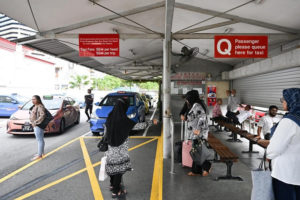ASEANEWS HEADLINE-EMPLOYMENT | SINGAPORE: Illegal but in demand: Singapore’s unlicensed taxi dilemma
A long line of licensed taxis waiting for passengers. PHOTO: THE STRAITS TIMES
.
.

ANN/THE STRAITS TIMES – For Kuan (not her real name) and her husband, making day trips across the border to indulge in good food and pampering spa treatments is a cherished ritual.
When travelling as a couple, they simply hop on the Causeway Link bus, which takes them from the Queen Street Bus Terminal near Ban San Street to Johor Bahru for less than SGD5 each. But when they want their 10-month-old baby to join in the fun, they need to explore other transport options.
.

.
For a recent four-day vacation to Johor, Kuan turned to a cross-border chauffeur service that she found online. She booked a seven-seater Toyota Innova as she needed more space for her family of three, her father-in-law, three pieces of luggage, a baby stroller and a car seat, which she requested at the point of booking.
On the day of their trip, a Malaysian driver showed up punctually to whisk them from their home in the east of Singapore to various attractions in the Johor coastal town of Desaru, before dropping them off at a hotel in Johor Bahru in the evening.
Kuan paid SGD300 for 12 hours of point-to-point service. It was not the most wallet-friendly option, but she had no complaints.
“My baby cannot walk yet,” said the manager in her 30s. “We need this service since we don’t have our own car.”
Kuan, however, was unaware that it is illegal for private hire drivers to offer cross-border rides without a valid public service vehicle licence (PSVL). She said the company’s website looked “legit”, so she did not question if the service provider was licensed.
At least 10 other Singaporeans told The Straits Times that they did not know the chauffeur service is illegal. And there are others, like Gerald (not his real name), who are undeterred by the law.
“It is convenient as someone is picking me up from my doorstep,” said the 27-year-old, who has used the service at least five times in 2024. He added that the service also provides him with respite from the crowd before he reaches his destination.
Enforcement stepped up
In the past two years, the Land Transport Authority (LTA) has caught 32 drivers for offering illegal cross-border passenger transport services using foreign-registered vehicles. The convicted drivers faced hefty fines, and their vehicles were seized.
Only Singapore- and Malaysia-registered taxis approved by LTA and Malaysia’s Land Public Transport Agency are authorised to provide cross-border rides. Besides the PSVL, Malaysia-registered taxis must also have an Asean public service vehicle permit, LTA said.
The designated pickup and drop-off points for these taxi rides are Ban San Street Terminal in Rochor and Johor Larkin Terminal (previously Pasar Bakti Terminal).
In the past, licensed taxi drivers were restricted to this specific route. But in 2012, the rule was relaxed to allow drivers to pick up or drop off passengers anywhere within their home country, while still requiring them to use the designated terminals after crossing the border.
“This arrangement ensures that foreign taxis do not ply the roads illegally to provide point-to-point services outside their home country,” LTA said in response to ST’s queries.
Despite the availability of licensed taxis, a frequent day tripper who wanted to be known only as Fong said he still prefers the private chauffeur service as he can negotiate for a cheaper fare.
“I usually go on Facebook and Telegram groups to look for such services, and have successfully negotiated with drivers to drive me from Johor Bahru to Tampines for between SGD25 and SGD30,” said Fong, who books these rides about eight times a year.
Currently, passengers can either look for cross-border taxis at Ban San Street Terminal, or book them via the hotlines of taxi operators like ComfortDelGro and Strides Premier. The fare is SGD70 for those who make advance bookings, SGD80 for home pickups and SGD120 for pickups from Changi or Seletar Airport.
Kuan said she would not mind paying more for licensed taxi rides – if a bigger car is available. “But they also have to offer point-to-point service and make it easier for us to book the rides on their apps. Otherwise, why do I want to pay so much for the taxi ride only to have to find another car after I reach Larkin?” she added.
Taxi drivers’ woes
During recent visits to Ban San on a Friday evening and Saturday morning, ST saw a long line of licensed taxis idling in wait of business. There were just a handful of passengers at the taxi stand, discussing if they could carpool and split the standard SGD60 fare.
Wong Yew Wah, 61, a Singaporean cross-border taxi driver, said this scene is a stark departure from the pre-pandemic days. “It used to be the passengers waiting for taxis, but the situation has reversed and taxis are now waiting for passengers instead.”
HJ Suhaimi, who manages three taxi associations in Johor, told ST that since the cross-border operations resumed in May 2022, Malaysian taxi drivers also wait for hours at Johor’s Larkin Terminal, as most passengers are “already picked up by unlicensed drivers elsewhere in Johor Bahru”.
A Malaysian taxi driver who wanted to be known only as Ramesh could testify to that. On most days, he drives to Larkin Terminal at 4am, pays a fee to secure a queue number and waits up to four hours for a passenger.
Then, he takes his passenger across the border to the Ban San Street Terminal and pays about SGD9 to park his car. Here, he has to get a queue number again and endures another long wait – sometimes 12 hours or more – as priority is given to Singapore taxis.
.

.
LTA said Singapore and Malaysia are each allowed to have 200 cross-border taxis. Currently, close to 300 taxis are offering cross-border rides.
To join this legal fleet, drivers must be a member of their respective countries’ cross-border taxi associations, said Suhaimi and Teng Kok Tai, chairman of the Singapore-Johor Taxi Operators’ Association.
Teng added that Singapore’s drivers have to pay a one-time administrative fee, as well as membership and monthly fees.
The requirement is similar for Malaysian drivers, but they do not have to pay an administrative fee, according to Suhaimi.
Licensed taxi drivers have long urged the authorities to crack down on illegal drivers, who have an unfair advantage as they are not obliged to pay for licences, memberships, full insurance coverage, mandatory vehicle inspection and taxes.
But several unlicensed private drivers told ST they are skirting the law in order to earn a better keep.
Unlicensed drivers’ plight
Ismail (not his real name) said many Malaysians who lost their jobs during the pandemic have yet to regain their footing and are struggling with skyrocketing costs of living.
“Times are tough. Nobody wants to intentionally do illegal stuff. But, for some of us, it’s the only way left to survive,” he said, adding that he is the sole breadwinner for his family of six.
Another unlicensed driver, George (not his real name), said he started offering illegal rides about five months ago.
Making six cross-border trips a day can earn him around SGD300 – far more than what he used to make in his last job, where a gruelling 12-hour working day brought in only SGD35.
“I’m choosing an easier way to make a living,” he said. “Furthermore, our customers choose our services because we are able to provide door-to-door pickups and drop-offs.”
Transport economist Walter Theseira said it would be challenging for licensed taxis to compete with the illegal door-to-door chauffeur service, which offers a fairly large variety of vehicles, ranging from budget to premium options.
“This is a case of the illegal market meeting a wider range of demand than the legal market,” the associate professor from Singapore University of Social Sciences said.
.

.
Pirate taxi era
He drew a parallel between the current situation and the pirate taxi era after World War II, when unlicensed services thrived due to the licensed players’ “slow adaptation”.
In those early years, pirate taxis – like private-hire cars these days – won over the crowd with their flexible routes and competitive fares.
Back then, some MPs had even proposed relaxing regulations against the “pirates”, as they were providing a widely valued service to the community at a time when licensed taxis and public buses could not meet the demand.
But pirate taxis were eventually phased out by the early 1970s, after the Government toughened enforcement, raised diesel taxes for private cars, increased the number of licensed taxis, expanded the public and school bus fleets and created employment for “pirates” under NTUC’s newly formed transport cooperative.
Rethinking regulations
“Historically, illegal markets for transport thrive when the legal market has too many barriers to allow legal players to meet demand,” Professor Theseira said.
“If the intended outcome is to regulate cross-border services better, it is likely that (we need) a combination of enforcement plus changes in regulation to allow a greater variety of service providers to enter the market legally,” he said.
Veteran transport engineering consultant Gopinath Menon also feels it would be beneficial to allow a new regulated private vehicle hire service between Johor and Singapore since there is a constant flow of people across the border.
Malaysian taxi driver Kasinathan Annamalai, 66, is hopeful for a regulatory tweak that would allow licensed taxis to go door to door. To him, that would be a more “long-lasting solution” than any number of spot checks or arrests.
Unlicensed Malaysian driver Raj (not his real name) also hopes to join the ranks of legal drivers.
“If both governments are willing to legalise our services, I would be willing to take it up, even if it means I need to pay more fees and taxes to drive around in Singapore,” he said.
Associate Professor Lin Weiqiang from the National University of Singapore’s geography department said the licensed taxi operators might also need to rethink their business model, which is “out of date in this internet world of platforms and super apps”.
His suggestion is for licensed taxi services to be listed on popular shopping platforms or bus ticketing sites such as Easybook for more visibility, instead of counting on hotline bookings alone.
Illegal ads
To further level the playing field for licensed taxis, LTA is also working with several prominent online platforms to remove advertisements for illegal cross-border rides.
Google said it has taken action on the ads reported by LTA. Similarly, Carousell said it has promptly removed non-compliant listings and urged users to report such listings. Meta declined to comment, while Telegram and travel booking platforms Klook and KKday did not respond.
Checks by ST in early September found that several websites, Facebook pages, Telegram groups and over 20 listings on Carousell are still advertising cross-border rides.
LTA urged the public to report the illegal services via its contact form or the OneMotoring website.
It also urged the public to stay clear of illegal rides for their own safety.
Insurance coverage
“These vehicles and their drivers are not appropriately licensed or insured, and would likely leave passengers without recourse if they are involved in a traffic accident,” LTA said.
Several insurers told ST they generally do not cover claims arising from unlawful acts.
Prudential Singapore said its customers will not be able to claim from their personal accident plans if they get into an accident while using illegal services.
Etiqa Insurance Singapore and Singlife said they would request to review documents including police reports, medical reports, and transportation confirmation or invoices to ensure the legitimacy of their customers’ travel insurance claims.
But some users of the illegal chauffeur services told ST they are willing to take the risks. In fact, Kuan said she felt safer having her baby travel in a car seat in an illegal car than going without one in a taxi. She added that a legal cross-border bus ride could be riskier, especially when she is not guaranteed a seat during peak hours.
“I do not want to risk falling with my baby if the bus were to stop or move suddenly,” she said.
However, should there be legal consequences for using the chauffeur service, Kuan said she would think twice before making her next booking.
Hoh Law’s associate director Bryan Lim told ST that neither the Road Traffic Act nor the Point-to-Point Passenger Transport Industry Act “contains any specific provisions that expressly make it an offence for a passenger” to use an unlicensed cross-border passenger transport service.
Chooi Jing Yen, a partner at the Eugene Thuraisingam law firm, said passengers could potentially be prosecuted for abetment, but this rarely happens.
But Jeremy Lim (not his real name) will err on the side of caution. The 29-year-old said he had hired a private car to avoid the long immigration queues at JB Customs on a weekend.
“But now that the e-gate situation in Malaysia has improved, and we’re able to move in and out of both countries more efficiently, there is no need for me to take the risk now that I know this service is illegal,” he added.
Retiree Simon Foo also swore off the illegal service after trying it during a sightseeing trip to Selangor with six friends in July.
Foo, who is in his late 60s, said his driver was tailgating other cars and sped along the Malaysian highways at 150kmh to 160kmh – well above the speed limit. In addition, two seat belts in the vehicle were faulty.
“An accident could happen in a fraction of a second on the highway and we could all die,” he said, adding that he learnt that this chauffeur service was illegal only after reading ST’s reports on LTA’s enforcement actions.
“My friends and I would not have used the service if we knew that it was illegal from the start,” he said. “As passengers, we need to be very aware of the risks we’re taking when we take such rides.”


@[email protected]


 Memento Maxima Digital Marketing
Memento Maxima Digital Marketing






